A NASA space capsule carrying the largest soil sample ever scooped up from the surface of an asteroid streaked through Earth’s atmosphere on Sept. 24 and parachuted into the Utah desert, delivering the celestial specimen to scientists.
The gumdrop-shaped capsule, released from the robotic spacecraft OSIRIS-Rex (Origins Spectral Interpretation Resource Identification Security - Regolith Explorer) as the mothership passed within 107,826km of Earth hours earlier, touched down within a designated landing zone west of Salt Lake City on the US military’s vast Utah Test and Training Range.
The final descent and landing, shown on a NASA livestream, capped a six-year joint mission between the US space agency and the University of Arizona. It was only the third asteroid sample, and by far the biggest, ever returned to Earth for analysis, following two similar missions by Japan’s space agency ending in 2010 and 2020.
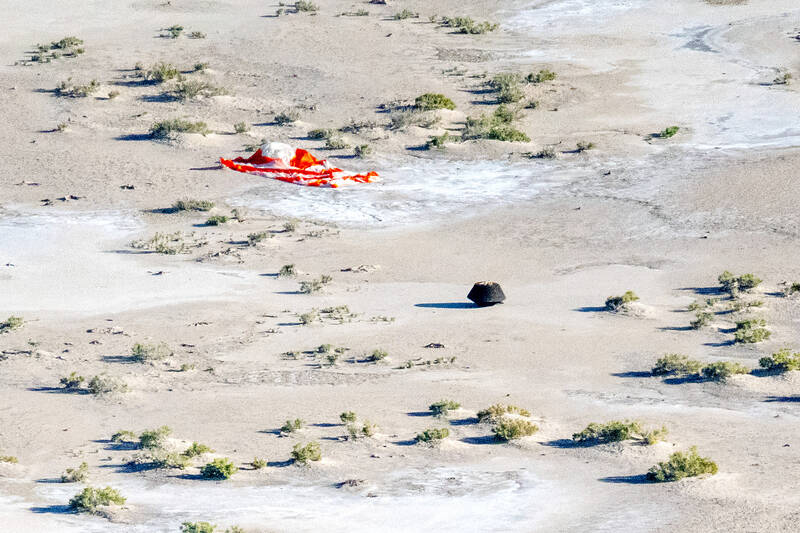
Photo: Reuters 照片:路透
After touchdown, the capsule laid nose-down on the sandy floor of the Utah desert, a red-and-white parachute that slowed its high-speed descent resting just feet away after detaching.
OSIRIS-REx collected its specimen three years ago from Bennu, a small, carbon-rich asteroid discovered in 1999. The space rock is classified as a “near-Earth object” because it passes relatively close to our planet every six years, though the odds of an impact are considered remote.
Apparently made up of a loose collection of rocks, like a rubble pile, Bennu measures just 500m across, making it wider than the Empire State Building is tall but tiny compared with the Chicxulub asteroid that struck Earth some 66 million years ago, wiping out the dinosaurs.
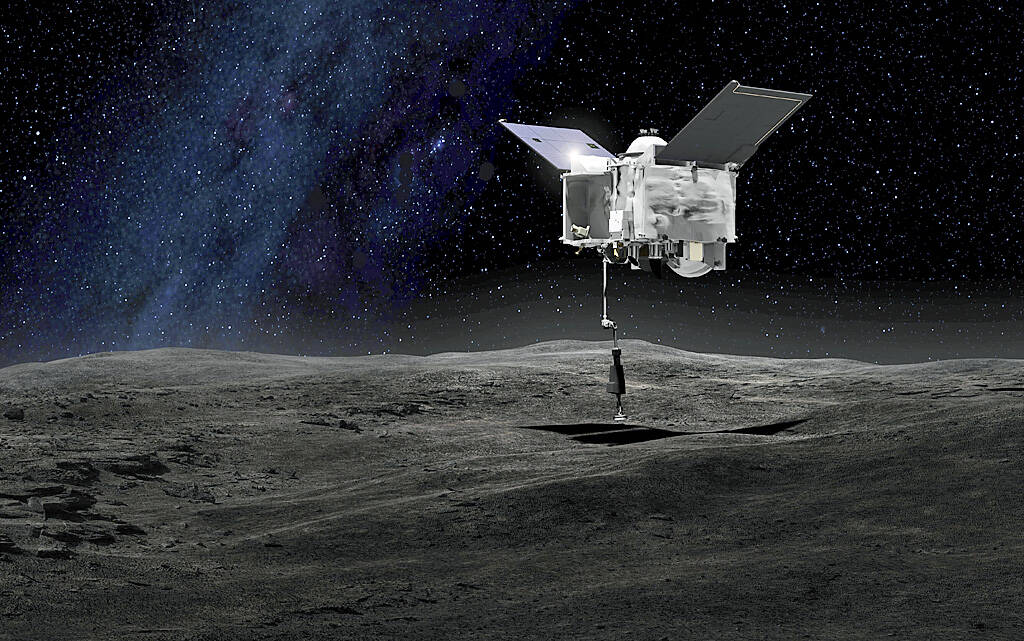
Photo: AP 照片:美聯社
Like other asteroids, Bennu is a relic of the early solar system. Because its present-day chemistry and mineralogy are virtually unchanged since forming some 4.5 billion years ago, it holds valuable clues to the origins and development of rocky planets such as Earth.
It may even contain organic molecules similar to those necessary for the emergence of microbes.
Samples returned three years ago by the Japanese mission Hayabusa2 from Ryugu, another near-Earth asteroid, were found to contain two organic compounds, buttressing the hypothesis that celestial objects such as comets, asteroids and meteorites that bombarded early Earth seeded the young planet with the primordial ingredients for life.
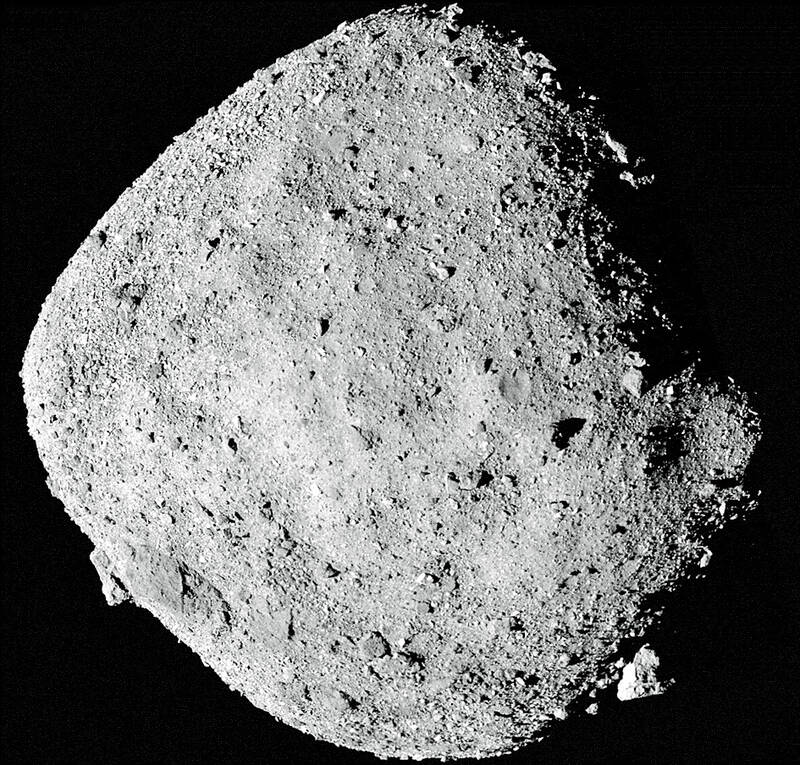
Photo: Reuters 照片:路透
OSIRIS-REx launched in September 2016 and reached Bennu in 2018, then spent nearly two years orbiting the asteroid before venturing close enough to snatch a sample of the loose surface material with its robotic arm on Oct. 20, 2020.
The spacecraft departed Bennu in May 2021 for a 1.9 billion km cruise back to Earth, including two orbits around the sun.
Hitting the upper atmosphere at 35 times the speed of sound about 13 minutes before landing, the capsule glowed red hot as it plunged earthward and temperatures on its heat shield reached 2,800 degrees Celsius.
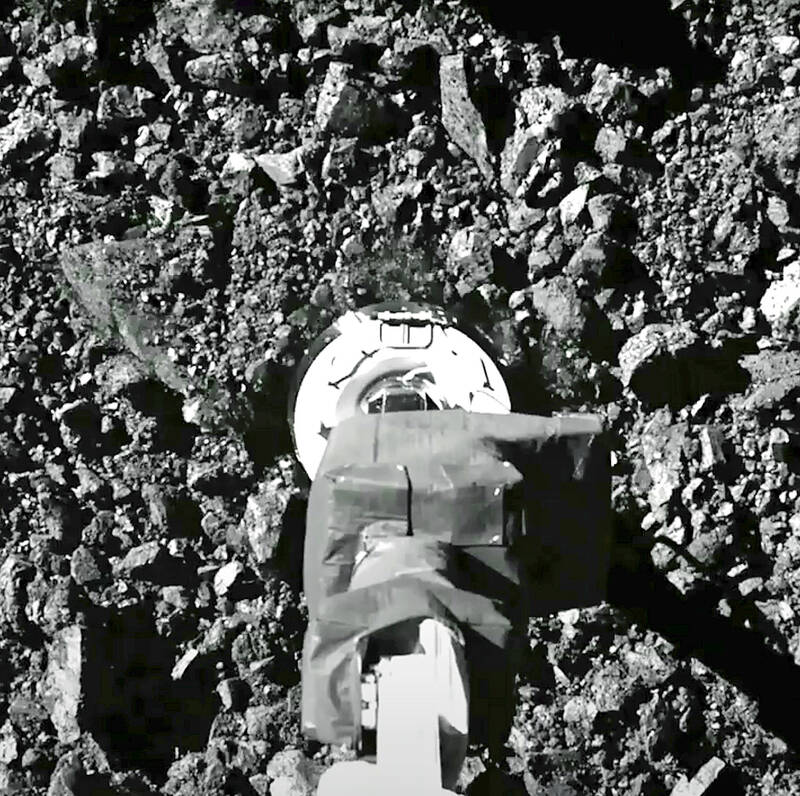
Photo: AP 照片:美聯社
The Bennu sample has been estimated at 250 grams, far surpassing the 5 grams carried back from Ryugu in 2020 or the tiny specimen delivered from asteroid Itokawa in 2010.
The main portion of the OSIRIS-REx spacecraft, meanwhile, is expected to sail on to explore Apophis, another near-Earth asteroid.
(Reuters)
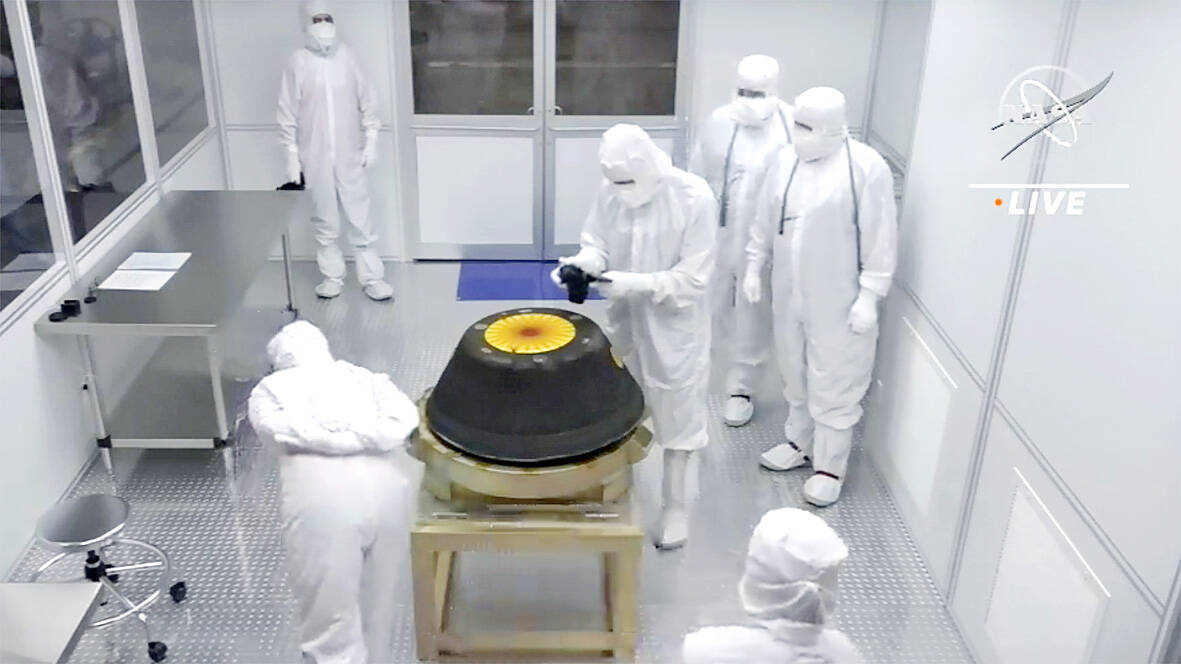
Photo: AP 照片:美聯社
美國太空總署的密封艙裝著從小行星表面挖出的最大土壤樣本,9月24日高速穿過地球大氣層,以降落傘著陸在猶他州沙漠,將給科學家的樣本送達。
數小時前,母船在經過距地球107,826公里以內時,水果軟糖形狀的密封倉從機器人太空船歐塞瑞斯號(OSIRIS-Rex,全名為「太陽系起源、光譜解析、資源識別、安全保障、小行星風化層探索者」)中彈射出來,降落在美國軍方猶他州測試暨訓練用靶場內的指定著陸區,該靶場是位於鹽湖城以西的一片廣大區域。
美國太空總署直播了最後的降落與著陸,為美國太空總署與亞利桑那大學為期6年的聯合任務畫上圓滿的句點。這是繼日本宇宙航空研究開發機構2010年及2020年完成兩次類似任務後,第3次將小行星樣本帶回地球分析,也是迄今所採集的最大樣本。
密封倉前端朝下著陸於猶他州沙漠的沙地上,減緩其脫離母船後下降高速的紅白相間降落傘,則落在數英呎外。
歐塞瑞斯號3年前在小行星貝努上採集了樣本,貝努是一顆富含碳的小型小行星,在1999年被發現。這塊太空岩石被歸類為「近地天體」,因為它每6年就會相對靠近地球一次,儘管撞上地球的可能性被認為很小。
貝努顯然是由一堆鬆散的岩石組成,像一堆瓦礫;它的直徑只有500公尺,比帝國大廈的高度長,但與大約6600萬年前撞擊地球、造成恐龍滅絕的希克蘇魯伯小行星相比,要小得多。
與其他小行星一樣,本努是早期太陽系的遺跡。由於它現今的化學及礦物性質自約45億年前形成以來幾乎沒有改變,因此它含有地球等岩石行星之起源與發展的寶貴線索。
它甚至可能含有類似微生物出現所需的有機分子。
日本隼鳥2號任務3年前從另一顆近地小行星龍宮帶回的樣本中,發現含有兩種有機化合物,這支持了這樣一種假設,即彗星、小行星和流星等天體轟擊早期地球,為地球這顆年輕的行星播下了種子,帶來生命的原始成分。
歐塞瑞斯號於2016年9月發射,在2018年到達小行星貝努,然後花了近兩年的時間繞著它運行,之後於2020年10月20日大膽靠近,近到得以用機械臂在其鬆散的表面抓取樣本。
該太空船於2021年5月離開貝努,航行19億公里(包括兩次繞太陽運行)返回地球。
密封艙在著陸前約13分鐘以35倍音速撞擊高空大氣,墜向地球時發出熾熱的紅光,隔熱罩的溫度達到攝氏2,800度。
採集自貝努小行星的樣本估計重250公克,遠超過2020年由龍宮小行星帶回的5公克及2010年從小行星絲川帶回的極小樣本。
歐塞瑞斯號太空船的主要部分同時將繼續航行,探索另一顆近地小行星阿波菲斯。
(台北時報林俐凱編譯)

A: For next weekend’s Golden Horse Awards ceremony, the Lifetime Achievement Award will go to Chen Shu-fang. B: Didn’t Chen win both Best Leading Actress and Best Supporting Actress in 2023? What a talented performer she is. A: But with the debut of the world’s first AI-generated “actress,” human performers may start to worry about their jobs. B: The news says the debut of AI-generated “actress” Tilly Norwood in a recent conference attracted studio executives’ interest. A: With big stars like Robert Redford and Diane Keaton passing away one after another, could human performers gradually be replaced in the future? A: 下週末登場的金馬獎,終身成就獎將頒給陳淑芳! B: 她前年不是同時贏得女主角、女配角獎?真是位好演員。 A: 但隨著全球首位人工智慧(AI)生成「女星」亮相,人類演員或許要開始擔心了。 B:
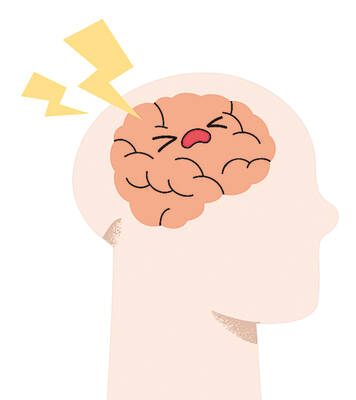
Have you ever felt a sudden pang of discomfort after handing over cash? That sensation is known as the pain of paying, the emotional sting that __1__ when money leaves your hands. Neuroscientific studies suggest that this pain activates the insula, an area in the brain associated with physical pain and negative emotions. This pain comes about because making a purchase forces people to __2__ the loss of financial resources, making the act of buying feel like a sacrifice. The pain intensifies under certain conditions. The more __3__ people are of the payment—its timing, amount, and method—the stronger the

It often starts with a text message asking if you are available on weekends, looking for a part-time job or you get a simple “hello” from an unknown number. Halfway across the world, a laborer is usually pulling in 12-16 hour days, sending non-stop messages, hoping someone will take the bait. The ultimate goal is always to take your money — victims have lost tens of billions to scams and hundreds of thousands of people are in forced labor to keep the schemes going. These workers are often housed in massive complexes scattered across Southeast Asia, where the industry has flourished. Here

1. 她把畫掛在書房牆上。 ˇ She hung the picture on her study wall. χ She hanged the picture on her study wall. 註:hanged 是 hang(吊死,絞死)的過去式。hang 作「掛」解時過去式是 hung,過去分詞也是 hung。 2. 他失去平衡,跌倒在地。 ˇ He lost his balance and fell down. χ He lost his balance and felled down. 註:felled 是動詞 fell 的過去式,作「砍倒」解,是及物動詞。這裡作「跌倒」解是 fall,過去式是 fell,過去分詞是 fallen。 3. 我剛才把照相機放在桌上。 ˇ I laid the camera on the table a moment ago. χ I lay the camera on the table a moment ago. 註:從句義可以看出動詞須用過去式「將…放、置」,動詞現在式是 lay,過去式和過去分詞都是 laid:lay, laid, laid;但 lay 也是 lie 的過去式,作「躺」解:lie, lay, lain,是不及物動詞。 注意:兩個形同義不同的 lay,不要用錯。 4. 他去過韓國。 ˇ He has been to Korea. ˇ He visited Korea some time ago. χ He has gone to Korea. 註:He has gone to Korea. 是「他已經到韓國去了」,指目前人已在韓國或在赴韓國的途中。表示「過去曾去過某處」,應用 have/has been,或用動詞的過去式和表示過去時間的副詞來表達。 5.